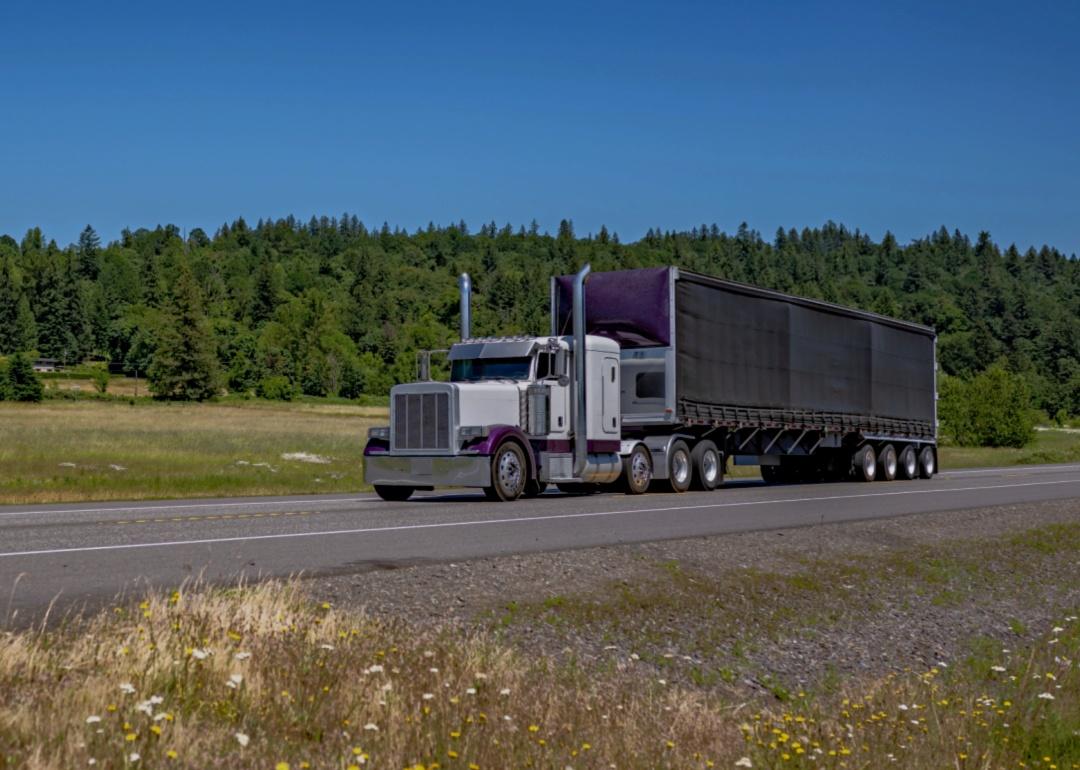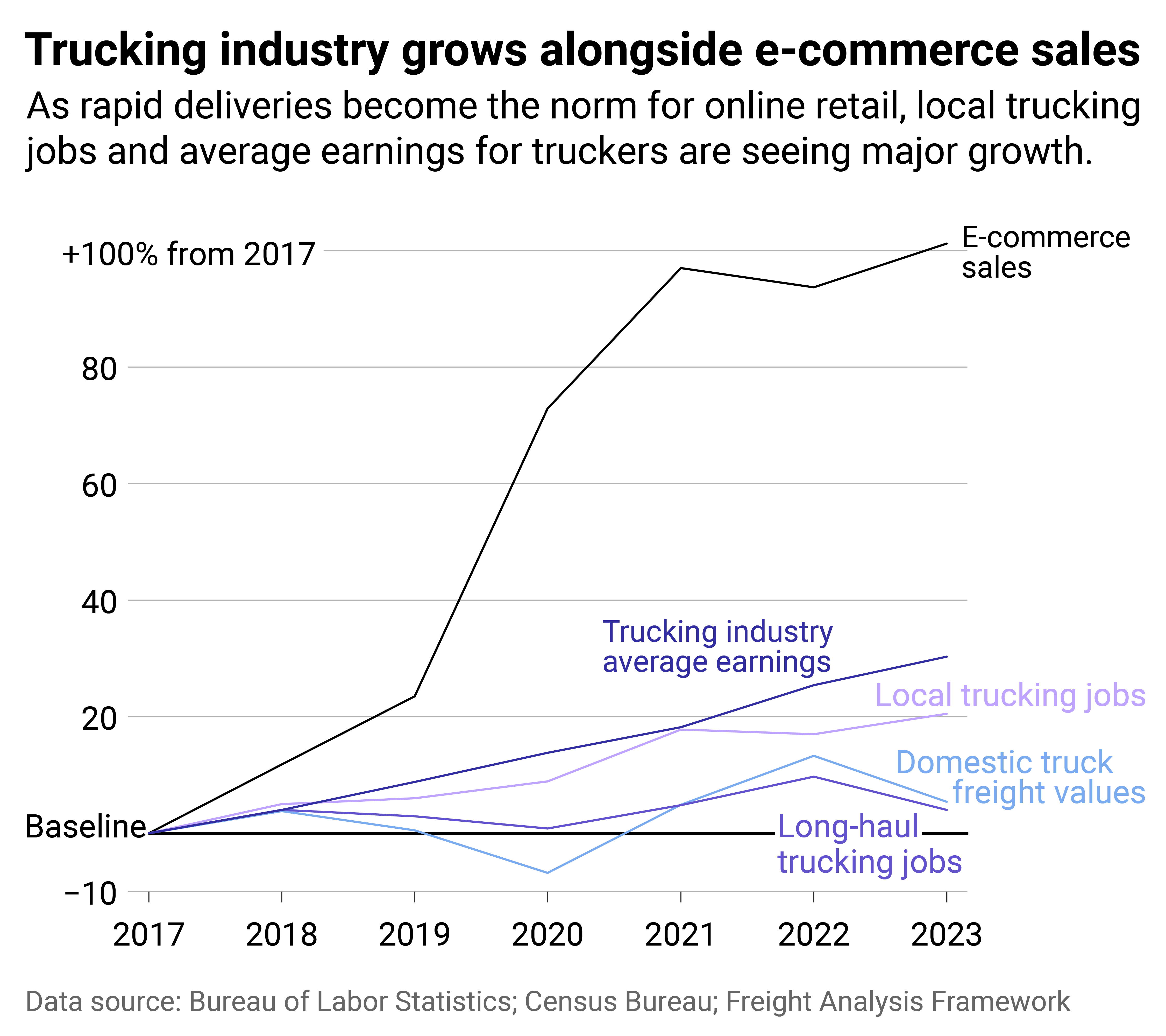
Here's how the rise in e-commerce is impacting America's truck drivers
This story originally appeared on Truck Parking Club and was produced and distributed in partnership with Stacker Studio.
Here's how the rise in e-commerce is impacting America's truck drivers
E-commerce sales eclipsed $1.1 trillion in 2023 and are pacing to climb even higher by the end of this year.
This surge has direct implications for truckers, who are charged with hauling these goods in large volumes and new ways. Truck Parking Club compiled data from the Census Bureau, Bureau of Labor Statistics, and Freight Analysis Framework to measure the growth in e-commerce and see how the trucking industry has responded.
Online sales are nabbing increasingly higher shares of overall retail in the U.S., growing from less than 1% of retail in 2000 to 16% midway through 2024, Census Bureau data shows. E-commerce is tightly interconnected with freight hauling and warehousing, essential steps that bring items from a shopper's online cart to their front door.
Increasing demand for fast, free delivery spurred by Amazon's standard-setting shipping times has raised the bar for other online marketplaces and put more pressure on logistics providers. Major transformations are already underway within the industry to be more time- and cost-efficient, including building warehouses more densely, ultimately creating a network of shorter-distance distribution sites.
As online shopping continues to become embedded into everyday life, the pressure on shipping and transport is unlikely to ease. These are some of the changes that have occurred so far.

As e-commerce has grown rapidly, local trucking jobs, wages see moderate gains
E-commerce sales have more than doubled since 2017, remaining elevated as new norms took hold amid the COVID-19 pandemic. While many people chose to start shopping online due to lockdown orders and social distancing mandates, most kept these habits even after restrictions eased. In turn, trucking industry earnings and local trucking jobs have grown substantially.
The most notable transportation industry effect was local freight driver jobs growth. In an e-commerce economy, short-distance truckers are much more necessary as companies store goods in more distributed warehouses rather than a few centralized locations. These roles grew by over 20% from 2017 to 2023—more than three times the overall job growth rate during that period. High volumes of short-distance truckers are critical to ensure the short delivery windows that shoppers have come to expect.
By comparison, long-haul trucking jobs have grown just 4% since 2017. While long-distance trucking still accounts for over 7 in 10 trucking jobs, local trucking jobs are beginning to claim a higher share of employment. The industry's changing landscape means many truck drivers can deliver goods closer to home rather than hauling freight to distant states throughout the week, allowing them to spend more time with their families.
Wages have also grown in recent years. Truckers can now expect to earn over $31 per hour on average, according to the Bureau of Labor and Statistics. Some companies are paying even more to truckers to elevate their e-commerce offerings and stay competitive in a high-demand field. This competition gives truck drivers more options in their job search and more leverage with their employers.
However, high quotas and package loads can mean long, grueling, and potentially dangerous working environments. Amazon, in particular, has come under fire regularly for overwhelming drivers with package volumes, which allegedly force them to skip breaks, drive recklessly, and use unsafe loading methods that could lead to back injuries. Within these and other challenging work conditions, the trucking industry is struggling to recruit and retain qualified applicants, all while their services are increasingly in demand.
Under the strain, new delivery technologies are emerging to find efficient ways to fulfill an ever-growing volume of online orders. Some are testing delivery drones, electric vehicles, and autonomous vehicles as solutions, which could eventually affect truck driver jobs available in the future.
Still, future job prospects are strong for truckers. The BLS projects the economy will add nearly 100,000 jobs between heavy truck drivers and light truck drivers over the next decade, with both occupations expected to grow faster than average among U.S. jobs. As experts project more e-commerce growth, it's likely these changes will continue to take hold in the American trucking industry.
Story editing by Carren Jao. Additional editing by Kelly Glass. Copy editing by Kristen Wegrzyn.



